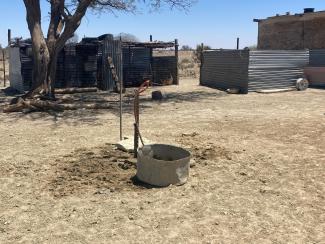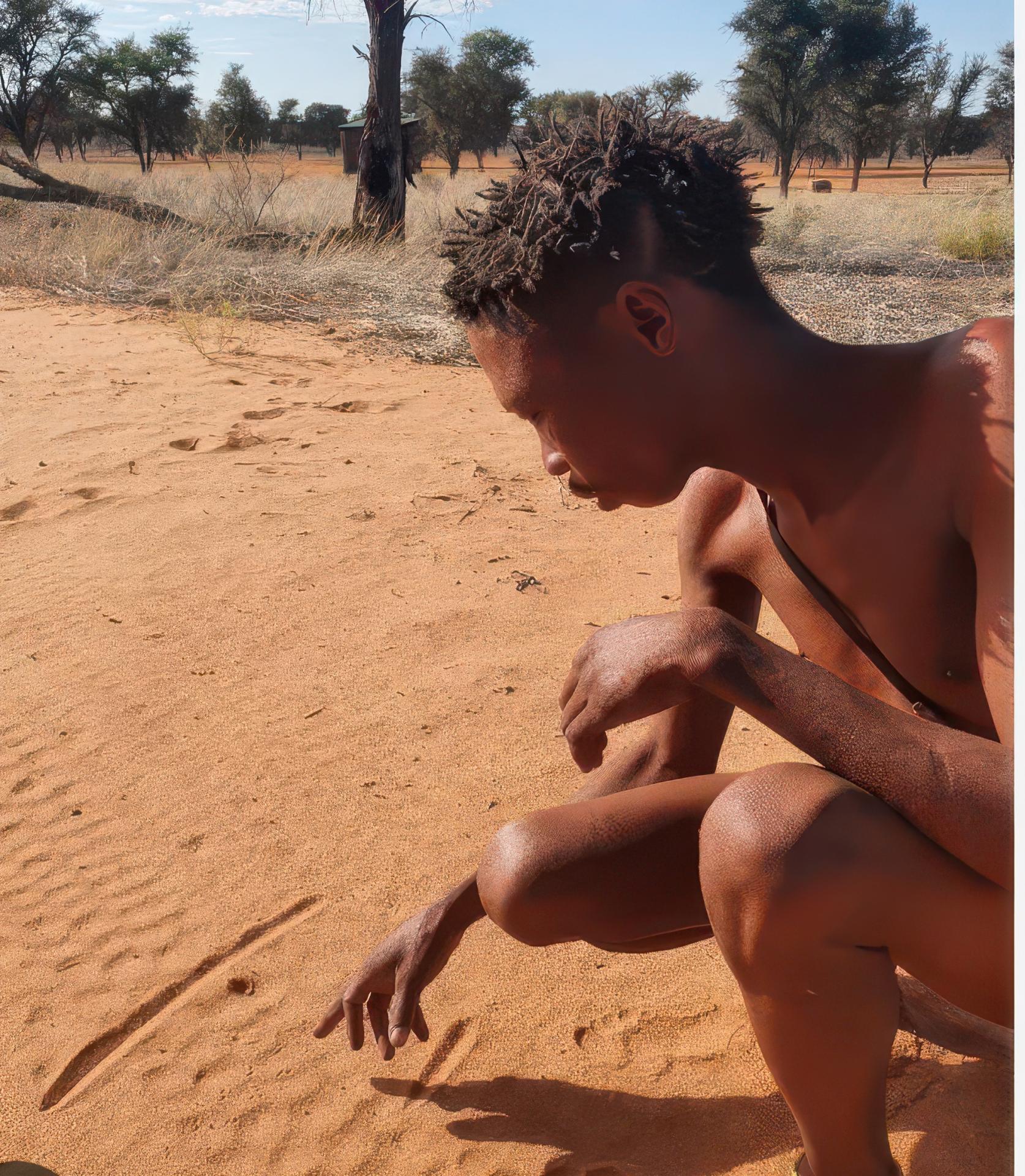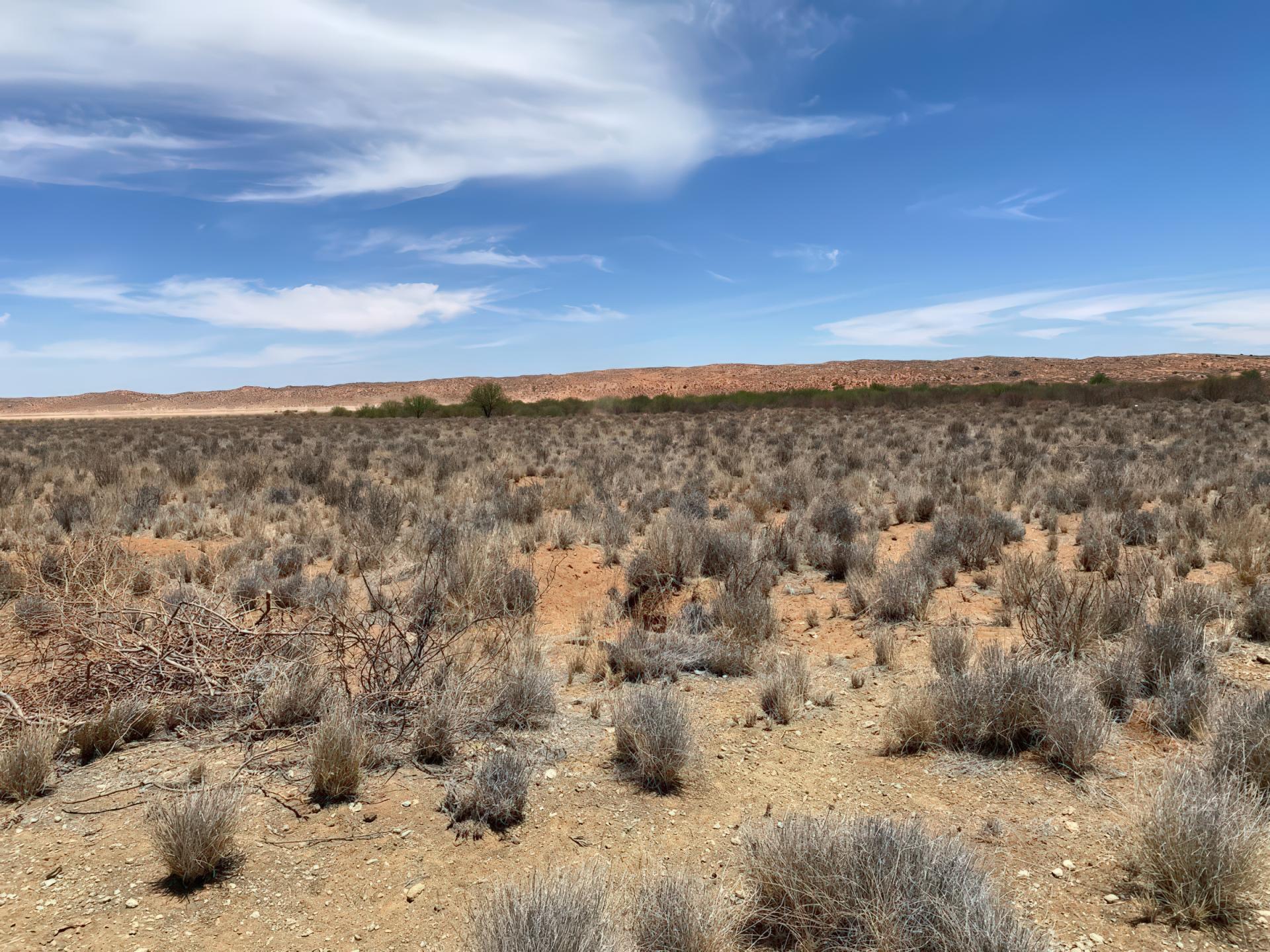
El pueblo San del sur del Kalahari ha prosperado en este duro entorno desértico durante más de 20.000 años, desarrollando una profunda conexión espiritual con la tierra y sus criaturas. Nuestras prácticas y conocimientos tradicionales nos han permitido adaptarnos a un clima implacable, y nuestra espiritualidad y conocimientos tradicionales desempeñan un papel vital en nuestra resiliencia. La espiritualidad Indígena es fundamental para abordar el cambio climático, ya que ofrece información valiosa sobre la interconexión de todos los seres vivos y la importancia de vivir en armonía con la naturaleza. Es esencial que tomemos medidas para apoyar a la comunidad San en sus esfuerzos por adaptarse al cambio climático.
Las prácticas tradicionales de los pueblos San están profundamente arraigadas en nuestra conexión espiritual con la tierra. Creemos que todo ser vivo tiene un espíritu y un propósito y que los seres humanos deben vivir en armonía con la naturaleza. Practicamos nuestras creencias en la forma en que rotamos las áreas de pastoreo para evitar el sobrepastoreo y promover el rebrote de la vegetación, lo que mantiene el equilibrio de la naturaleza. Utilizamos técnicas de manejo de incendios para mantener la salud del ecosistema y prevenir incendios forestales devastadores y como una forma de comunicarnos con los espíritus de la tierra. También implementamos métodos de agricultura de conservación para mejorar la fertilidad del suelo y retener la humedad, nutriendo los espíritus de la tierra. Todas estas prácticas son ejemplos de nuestra profunda relación con la naturaleza.
Los conocimientos tradicionales y los medios de vida de la comunidad San están amenazados por la desertificación y el cambio climático. La pérdida de plantas medicinales, los cambios en los patrones de lluvias y el aumento de las temperaturas devastan el modo de vida de la comunidad San. Las estaciones en la región de Kalahari han cambiado drásticamente con el tiempo, y las temperaturas máximas y bajas extremas han aumentado aún más. Willie Eyman, un activista comunitario de Rietfontein, recuerda: "Nací y crecí en Kalahari en la década de 1980. Se veía verde, los animales podían alimentarse y las comunidades vivían del campo y de los alimentos que proporcionaba. Con el paso de los años, el cambio climático y, especialmente, la desertificación son cada vez más preocupantes. Cuando éramos niños, podíamos jugar al sol, pero hoy el sol llega a 40° C y más, lo que hace que sea más peligroso para los niños jugar en el campo.

Rastreador San, Ghopan, mostrando rastros en la arena.
La desertificación en Sudáfrica es un grave problema ambiental. Casi el 91% de la tierra del país se considera propensa a la desertificación debido a las grandes áreas de tierras secas, lo que la hace muy vulnerable a la degradación de la tierra y a la propagación de condiciones desérticas. Esto es especialmente cierto en la región del Cabo Norte, donde factores como el pastoreo excesivo, la mala gestión de la tierra, el cambio climático y los cambios en los patrones de lluvia han contribuido a la erosión del suelo y a la pérdida de cobertura vegetal. El pueblo San ha sido tradicionalmente cazadores-recolectores, dependiendo de la tierra para obtener alimentos y otros recursos esenciales. Sin embargo, con los cambios en los patrones de lluvia, la tierra se está volviendo cada vez más estéril, lo que les dificulta encontrar los alimentos y los recursos necesarios para sobrevivir.
Los San siempre han vivido en armonía con la tierra, utilizando materiales naturales para construir sus casas y refugios. Sin embargo, con el aumento de las temperaturas, estos materiales son cada vez más escasos, lo que dificulta el mantenimiento de su forma de vida tradicional. Petrus Vaalbooi, un líder tradicional de los ! Khomani San, comenta: "Hace cincuenta años, la región de Kalahari estaba repleta de animales como el órix del cabo, ñus azules y otros animales que se cazaban. Hoy en día, los patrones climáticos han cambiado y, a medida que la comida se pierde debido al calor, los animales migran más. También se está convirtiendo en un problema para los agricultores de la zona, ya que las dunas se están volviendo más rojas, ya no son como hace 30 o 50 años. Estamos viendo más dunas rojas a medida que la tierra se degrada. Los granjeros ponen 2.000 ovejas en un área donde solo deben ir 1.200, o 400 vacas donde solo deben ir 100. Es un problema tanto para los animales como para la tierra y su gente".
El cambio climático también está afectando al rico patrimonio cultural de la comunidad San, con su fuerte énfasis en la narración de historias, la música y el arte. Con la pérdida de los conocimientos tradicionales y de los medios de vida, este patrimonio cultural se ve amenazado, ya que la educación occidental está superando a los conocimientos tradicionales. Los conocimientos tradicionales y los medios de vida de la comunidad San están estrechamente vinculados a su patrimonio cultural, y la pérdida de estos está teniendo un impacto devastador en su identidad cultural.

Plantas medicinales: una parte vital de los medios de vida de los San
Uno de los impactos más significativos del cambio climático en la comunidad San es la pérdida de plantas medicinales. Nuestro pueblo ha confiado tradicionalmente en estas plantas por sus propiedades medicinales, utilizándolas para tratar una variedad de dolencias, desde fiebre hasta mordeduras de serpientes. Sin embargo, debido a los cambios de temperatura y los patrones de lluvia, muchas de estas plantas están desapareciendo. Los cambios en los patrones de lluvias están afectando la capacidad de la comunidad San para cultivar y recolectar alimentos, mientras que el aumento de las temperaturas está alterando la distribución de plantas y animales, lo que dificulta la adaptación de la comunidad.
Las plantas medicinales de la región de Kalahari son un tesoro de conocimientos tradicionales y una piedra angular de la salud y el bienestar de la comunidad. También tienen un inmenso significado espiritual. Varias de estas plantas han ganado importancia comercial en los últimos años, con productos como el Buchu, Sceletium y el té Rooibos que se cosechan y comercializan a nivel mundial. La pérdida de estas plantas debido a la desertificación y el cambio climático tendría efectos devastadores en los medios de vida de los San, ya que estas plantas ahora tienen que cultivarse dentro de túneles de invernadero y ya no de forma natural.
Adaptación al Cambio Climático: un imperativo espiritual
El pueblo San creen que el cambio climático es una señal de la angustia de la tierra y que los seres humanos deben tomar medidas para restaurar el equilibrio de la naturaleza. Están tomando medidas proactivas para abordar el cambio climático, como el establecimiento de áreas de conservación dirigidas por la comunidad para proteger los sitios sagrados y promover la biodiversidad, el desarrollo de proyectos de agricultura resistente al clima que incorporen prácticas tradicionales y valores espirituales, y la creación de sistemas de alerta temprana para eventos climáticos extremos que incorporen el conocimiento tradicional y las percepciones espirituales.
Una de las soluciones más amplias para combatir la desertificación y facilitar la restauración de las tierras consiste en abordar los ciclos del agua degradados y la pérdida de fertilidad del suelo. En 2024, el Departamento de Pesca, Silvicultura y Medio Ambiente, la Unión Internacional para la Conservación de la Naturaleza y el Centro para el Cambio Global de la Universidad Sol Plaatjie lanzaron el Proyecto de Gestión Sostenible de la Tierra GEF7 en Kalahari, cuyo objetivo es ampliar e incorporar la gestión sostenible de la tierra para lograr un impacto a gran escala en las tierras de pastoreo. En 2024, a medida que la Universidad comenzó a involucrarse con las comunidades Indígenas en varios proyectos, ahora más comunidades quieren participar. Nuestras comunidades ahora pueden participar activamente y nuestro conocimiento intelectual y compartido se utiliza de manera económica para beneficiarnos y crear un sistema de alerta temprana para cambios en los patrones climáticos extremos utilizando nuestros antiguos valores tradicionales y percepciones espirituales.
Los Khomani San han establecido un Área de Conservación Liderada por la Comunidad dentro de su Parque Transfronterizo de Kgalagadi en la Región de Kalahari en la parte de Cabo Norte, restaurando la tierra a la comunidad y arrendándola a los Parques Nacionales Sudafricanos (SanParks). De esta forma se permite a los Khomani San mantener sus derechos culturales y utilizar la tierra para fines tradicionales, al mismo tiempo que se benefician de los ingresos generados por el parque.
Oom David Boch, un residente de Philandersbron, dice: "Ahora que el gobierno ha visto cómo estamos luchando en el Kalahari, ahora tenemos esperanzas de poder plantar papas, calabazas e incluso uvas. Los miembros de la comunidad también solían plantar higos. Estábamos prosperando, pero a medida que cambiaban los patrones climáticos y no llovió más, la tierra se secó. Se puede ver cuando y si llueve; el campo ahora tiene rastros profundos por donde corre el agua y crea estos cráteres".
Klaas Witbooi, conocido cariñosamente por la comunidad como Oom Klaas, ha visto años de temporadas de lluvias, pero en los últimos siete años, ha visto cada vez menos lluvias en la zona. Dice que la alimentación animal e incluso la alfalfa son caras. "Soy jubilado, pero mi amor por los animales siempre me ha ayudado a salir adelante, especialmente en estos tiempos difíciles. Tenemos la esperanza de que, con la ayuda del gobierno en el proyecto denominado GEF7, nuestra gente pronto entrará en Canaán, la tierra de la leche y la miel".
La conexión espiritual con la tierra y sus criaturas está en el corazón de nuestra resiliencia. Al reconocer y apoyar nuestros conocimientos y prácticas tradicionales, podemos mejorar la resiliencia de los ecosistemas, promover la gestión sostenible de la tierra y apoyar los esfuerzos de adaptación y mitigación del cambio climático. Hacemos un llamado a los gobiernos y a las organizaciones de conservación para que respeten nuestras prácticas y conocimientos y colaboren con los pueblos San para construir un futuro más resiliente para el sur del Kalahari que honre la conexión espiritual entre los seres humanos y el mundo natural. Nueva York y Shanghái pueden tener la tecnología, pero el Kalahari ha utilizado los sistemas durante siglos.
Brain Miennies (San) es conservacionista de la naturaleza. Trabaja como director general de Kalahari Earth Keepers International. También es secretario general adjunto de la Asociación Comunitaria de Sudafricanos en Recursos Naturales en Sudáfrica.
Foto de portada: Casi cerca del 91% de Sudáfrica es propensa a la desertificación. Foto por Brain Miennies.
